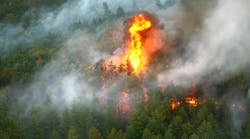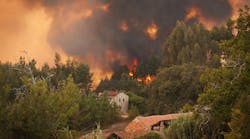Maintaining vegetation along utility rights-of-way is a critical component of providing safe and reliable power. For many years, the only tool used to accomplish this was a chain saw to remove tree limbs closest to power lines. The electric utility industry has changed rapidly in the last several years, and there are now so many vegetation management tools available it is difficult to determine which ones fit within a particular integrated vegetation management (IVM) program.
To implement an effective IVM program, utility arborists should use a wide variety of tools, including tree growth regulators (TGRs). Foresters across the country are implementing TGRs in their IVM programs to help reduce costs, increase reliability and improve stakeholder relations.
Cost Savings and Reliability
Grant Ehlen from American Electric Power (AEP) has been using TGRs for many years. When he first started using TGRs in Oklahoma, Ehlen found they provided significant cost savings by reducing pruning for the next cycle. For example, he pruned and treated 1,300 trees with paclobutrazol on one circuit. When he returned to the circuit after three growing seasons, he found only 200 of the trees needed to be pruned, resulting in a 60% cost savings.
A high-cost pruning situation is another area where Ehlen used TGRs to reduce costs. Because of limited access to 100 backyard trees, Ehlen treated these trees with paclobutrazol. These trees had a history of being “cycle busters,” growing back into the line before the next scheduled maintenance. However, when using paclobutrazol, Ehlen saw a 35% cost reduction with these trees over four years and there was no need to prune them mid-cycle.
When Ehlen moved from Oklahoma to AEP Texas, he found additional benefits of TGRs. In one instance, he had a circuit scheduled to be pruned because of a large number of outages. Due to budget constraints, the $144,000 required to prune the circuit was not readily available. Ehlen chose to spend $28,000 to treat the trees with paclobutrazol to delay the need for pruning until budget dollars were available. After the trees were treated, power reliability within the circuit improved and Ehlen was able to wait three years before pruning the circuit.
Joe Osborne with Oklahoma Electric Cooperative (OEC) also has experienced cost savings with TGRs. One of the most critical and sensitive areas in the OEC service territory is the city of Norman. Osborne originally implemented TGRs in 2007 to reduce the number of site visits he would have to make to manage the vegetation in this sensitive area. When Osborne later reviewed pruning requirements and associated costs in the western part of Norman, he found a 60% reduction in the amount of pruning and an estimated $39,000 cost savings over a four-year cycle after implementing TGRs in this area of the city.
Sensitive Areas
AEP Texas also has implemented TGRs in the city of McAllen. AEP forester Jesse Alvear has worked closely with McAllen urban forester Mark Kroeze to help manage the interface between public safety and the need for tree preservation based on cultural and historical needs. One example where they implemented paclobutrazol was at McAllen-Miller International Airport, where several hackberries and cedars were obstructing the view of the air traffic control tower. These trees were planted in the adjoining cemetery and had significant historical value to relatives of the deceased.
Alvear and Kroeze decided to partner on this sensitive issue and brought in Edko, LLC to apply Cambistat to the trees in the cemetery. The goal was to reduce the disturbance to the cemetery by extending the current annual pruning cycle, reducing the time and labor at the site, and maintaining the health of the trees. After treatment in June 2009, the trees have continued to be healthy and have not required any pruning in the three years since the project began.
Increased Worker Safety
Steve Stewart and Rob Mercer from Georgia Power implemented a TGR project on St. Simons Island, the largest of the Golden Isles along Georgia's southern Atlantic Coast. St. Simons Island brings many unique challenges to a utility forester because of its long growing season and busy tourism industry.
Georgia Power maintains most of its circuits on a three-year pruning cycle by getting at least 15 ft (4.6 m) of clearance. However, St. Simons Island is on a two-year pruning cycle (and on an annual cycle for a few main roads). This situation causes safety concerns related to closing lanes and blocking traffic, and incurs high vegetation management costs. Stewart and Mercer chose to implement a TGR project in this area to see if they could extend the pruning cycles on the island, which would reduce their costs as well as worker and public exposure to safety risks.
The TGR project was implemented in spring 2012. Edko was hired to inventory the trees on the island and group them into three categories based on how quickly they needed to be pruned. All costs were recorded for trees that were pruned and trees treated with Cambistat. The biomass removed from the pruned trees also was weighed so biomass reduction could be evaluated over time. Georgia Power will be looking at this site over the next couple of years to determine cost savings and how it can lengthen the pruning cycle to reduce the headaches and safety risks that come with lane closures.
Maintaining Cycles
Kevin Scott from Indiana Michigan Power has been using TGRs to help maintain cycles within his system. In 2011, he had several circuits inspected that had been pruned and treated with TGRs in 2007 and 2008. The inspector determined how much clearance the spans still had in 2011. The specification Scott gave tree contractors was to prune trees to maintain clearances for three to five years before the trees would be pruned again during normal cyclical maintenance.
What the inspector found after looking at more than 6,500 spans of overhead power lines was 78% of the spans had at least seven years of clearance (as opposed to the three- to five-year clearance for which they were pruned) with a single application of TGRs. Of the overhead spans treated with TGRs, more than 94% of them had no clearance issues for five years after pruning. Paclobutrazol has helped Scott extend his cycles and reduce the amount of mid-cycle work needing to be done.
In California, Rob Askine has been applying TGRs for Sacramento Municipal Utility District (SMUD) since 2000. The main benefit SMUD achieves from using TGRs is extending and maintaining its pruning cycles. Eucalyptus trees can often grow up to 10 ft (3 m) in a year after they are pruned away from overhead lines; needless to say, it is difficult maintaining a three-year pruning cycle when trees grow that quickly.
SMUD has treated more than 2,100 eucalyptus trees in the past 12 years, and its use of TGRs has been instrumental in helping the utility maintain cyclical pruning. SMUD often sees less than 1 ft (0.3 m) of growth the year following a TGR application, and it typically sees growth control for three years to five years. The utility has seen no ill effects on the trees treated multiple times during the last 12 years.
Advancing the Industry
These are just some of the examples from around the country of utility foresters implementing TGRs into their overall IVM programs. In years past, vegetation management consisted of pruning trees away from power lines to ensure branches would not grow into the wires for three to five years. Sometimes branches caused outages before the next pruning cycle and sometimes they did not. The process would then be repeated over and over again.
In the United States, between $3 billion to $5 billion is spent each year on utility vegetation management, yet trees are still a leading cause of outages. Some benchmarking studies show roughly one-third of outages are caused by trees. The electric utility industry uses the system average interruption frequency index (SAIFI), the system average interruption duration index (SAIDI) and several additional formulas to determine the effectiveness of vegetation management. By using these measures, it can be seen the average person experiences 1.1 outages per year (not including major storms) that last 1.5 hours. These figures have not improved over the last several years, and they will not improve by doing the same things that have always been done.
At one time, the most brilliant minds in the world knew the earth was flat; some experts stepped outside the box and proved the earth was round, and it changed everything.
The electric utility industry can change, too, by stepping outside of the box and using TGRs, along with system analysis, pre-inspections, global positioning system, light detection and ranging technology, low-volume herbicides, dormant season spraying, aerial saw work, tree risk assessments and the many other vegetation management tools now available.
Jim Nesser is the national utility sales manager for Rainbow Treecare Scientific Advancements, working with utility and application companies to enhance their vegetation management programs by implementing TGRs into IVM plans. Nesser holds a BS degree in forestry with an emphasis on hydrology and soils from the University of Minnesota. He is an ISA certified arborist/utility specialist and has served on the Utility Arborist Association training committee for the past three years. Prior to joining Rainbow Treecare Scientific Advancements, Nesser spent seven years as a field arborist in the commercial and utility market.
How TGRs Work
Tree growth regulator technology has been around for more than half a century. Over the past 10 years, paclobutrazol has emerged as the most effective and predictable active ingredient. The product is applied to the soil around the base of a tree and transported to the growing points of the tree during transpiration. It works by reacting in the subapical meristems of the plant to inhibit the production of gibberellins responsible for cell elongation.
When paclobutrazol is applied, the plant still has the same amount of energy available but uses less energy for vegetative growth. Since less energy is allocated to growth, the plant has more energy available for reproductive structures, fine root development, storage compounds and increased defense compounds. This change in growth leads to increased chlorophyll density, thicker leaves, more abscisic acid and a plant more suitable to the hostile conditions of the urban forest.

